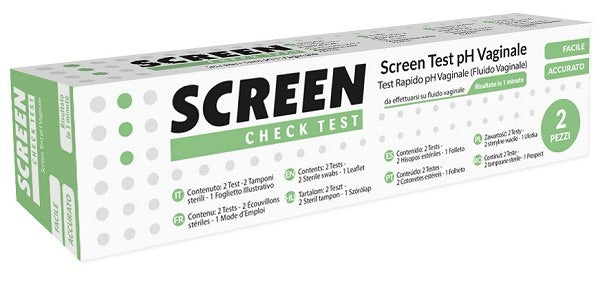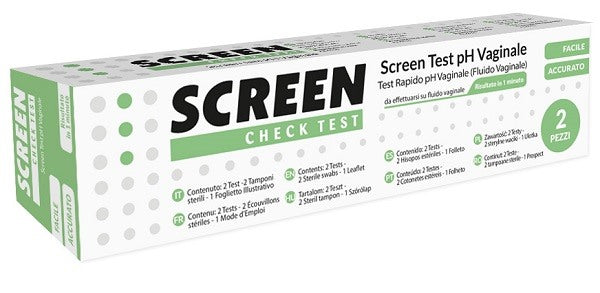SCREEN TEST PH VAGINAL 2 PIECES SCREEN ITALIA
32% off
€9,24
€13,50
Unit price
/
Unavailable
Tax included, shipping and discounts calculated at checkout.
SCREEN ITALIA Srl | SKU:
971664584
Notify me when it's back in stock!
Write us your email, you will be notified when this product becomes available again!
SCREEN TEST PH VAGINAL 2 PIECES SCREEN ITALIA is backordered and will ship as soon as it is back in stock.
Shipping Costs and Times
Shipping Costs and Times
- Order fulfillment within 24 hours and delivery within the following 48/72 hours.
- Shipping cost: always free for orders over €49.90, otherwise it costs €4.99.
Payments
Payments
Payment information is processed securely. We do not store credit card information or have access to your credit card information.
Returns and Refunds
Returns and Refunds
You can return and receive a refund for the item within 30 days. See full policy here.

Do you need help?
Our customer service is here to help you!
- Contact us by phone, email or WhatsApp, from Monday to Friday, from 9:00 to 20:00 .
- For common questions, such as tracking your order or checking its fulfillment status, you can count on our artificial intelligence , available 24/7 .
We are always at your side to offer you fast and effective support!
Description
Description
SCREEN TEST PH VAGINAL 2 PIECES SCREEN ITALIA
SCREEN
CHECK TEST
Vaginal pH Description
In vitro diagnostic medical device CE 0123.
Rapid test for the semi-quantitative determination of pH in female vaginal swab specimens.
For in vitro self-diagnostic use only.
6It is a rapid dry chemical method to aid in the diagnosis of bacterial vaginosis.
Precautions
1. In vitro diagnostic device for individual use. Do not use beyond the expiration date.
2. Do not eat, drink or smoke in the specimen and kit handling area.
3. The used test must be disposed of according to local regulations.
4. Humidity and temperature can negatively affect the results.
5. Do not use if package is damaged.
6. Single-use tests.
7. Use only the swab provided with the kit.
8. Open the swab package just before collection.
9. DO NOT use the test within 72 hours of using vaginal preparations such as birth control creams and vaginal medical products (antifungal agents, vaginal suppositories, creams, gels, douches, etc.).
10. DO NOT use the test within 48 hours of sexual intercourse.
11. DO NOT use the test within 5 days of your period.
Sample collection and preparation
The rapid vaginal pH test (vaginal swab) can be performed using a female vaginal swab specimen.
1. Wash your hands before starting the test.
2. Open the package, remove the swab from the package, do not touch the tip of the swab (polyester tip).
3. Separate the labia to expose the vagina.
4. Gently insert the tip of the swab into the vagina and press gently until about 5 cm of the swab is inside the vagina, for about 10 seconds. A time of 10 seconds is important to ensure that the tip of the swab is well soaked in vaginal secretions. Sufficient inhibition is very important for the evaluation of the test.
5. Remove the swab from the vagina for testing.
How to use
Bring the test, reagents, specimen and/or controls to room temperature (15-30°C) before performing the test.
1. Remove the test from the sealed package and use it within one hour. Best results are obtained if the test is performed immediately after opening the package.
2. Place the test on a clean, flat surface.
3. Place the tip of the swab soaked in vaginal secretion on the pH area of the test at least 5 times, making sure that enough secretion is applied to the pH area of the test.
4. Read the results immediately while the measuring area is still wet. Compare the color of the pH area with the reference on the package and note the corresponding color scale value closest to the test. After evaluation, discard the test and the swab.
Interpretation of results
Results are obtained by visually comparing the pH measuring area with the color scale on the test package.
NORMAL RANGE: Vaginal pH levels 3.8-4-4 are within normal range. The indicator color is yellow-green.
ABNORMAL RANGE: Vaginal pH levels above 4.4 or below 3.8 are out of the norm. When pH levels are above 4.4 the indicator color is green-blue, when pH levels are below 3.8 it is bright yellow.
Limits
1. Some menopausal women have a high vaginal pH, and therefore may obtain an abnormal result even if they do not suffer from bacterial or parasitic infections.
2. Some factors (menstrual cycle, sexual intercourse, vaginal pharmaceuticals) can temporarily alter the vaginal pH level and may induce false results. Therefore, take appropriate precautions before performing the test.
3. Do not wash or wet the area just before testing.
4. Caution: Urine may cause false test results.
5. Never start any therapy before discussing it with your doctor.
6. In case of improper use, the female hymen may break, as in the case of sanitary towels.
7. This is NOT a test for sexually transmitted diseases, such as HIV, chlamydia, herpes, gonorrhea, or syphilis.
Conservation
Store in the sealed container at room temperature (2-30°C).
The test is stable until the expiration date printed on the package. The test must remain in the sealed package until use. Do not use beyond the expiration date.
Format
Pack of 2.
BIBLIOGRAPHY:
1. Panda Subrat, Das Ananya, Singh Ahanthem Santa, Pala Star. Vaginal pH: A marker for menopause. Journal of mid-life health, 2014, Vol.5 (1), pp.34-7.
2. Roy Subir, Caillouette James C, Faden Joel S, Roy Tapon, Ramos Diana E. Improving appropriate use of antifungal medications: the role of an over-the-counter vaginal pH self-test device. Infectious Diseases in Obstetrics and Gynecology, 2004, Vol.11 (4), pp.209-16.
3. Maloney C, Oliver M L. Effect of local conjugated estrogens on vaginal pH in elderly women. American Medical Directors Association. Jpurnal, 2003, Vol.2 (2), pp.51-5.
4. Hanna NF, Taylor-Robinson D, Kalodiki-Karamanoli M, Harris Jr, McFadyen I R. The relationship between vaginal pH and the microbiological status in vaginitis. British Journal of Obstetrics and Gynaecology, 1985, Vol.92 (12), pp.1267-71.
5. Nakra Natasha A, Madan Pellett, Buckley Niall etc. Loss of Innate Host Defense Following Unprotected Vaginal Sex. The Journal of infectious diseases, 2016, Vol.213 (5), pp.840-7.
In vitro diagnostic medical device CE 0123.
Rapid test for the semi-quantitative determination of pH in female vaginal swab specimens.
For in vitro self-diagnostic use only.
6It is a rapid dry chemical method to aid in the diagnosis of bacterial vaginosis.
Precautions
1. In vitro diagnostic device for individual use. Do not use beyond the expiration date.
2. Do not eat, drink or smoke in the specimen and kit handling area.
3. The used test must be disposed of according to local regulations.
4. Humidity and temperature can negatively affect the results.
5. Do not use if package is damaged.
6. Single-use tests.
7. Use only the swab provided with the kit.
8. Open the swab package just before collection.
9. DO NOT use the test within 72 hours of using vaginal preparations such as birth control creams and vaginal medical products (antifungal agents, vaginal suppositories, creams, gels, douches, etc.).
10. DO NOT use the test within 48 hours of sexual intercourse.
11. DO NOT use the test within 5 days of your period.
Sample collection and preparation
The rapid vaginal pH test (vaginal swab) can be performed using a female vaginal swab specimen.
1. Wash your hands before starting the test.
2. Open the package, remove the swab from the package, do not touch the tip of the swab (polyester tip).
3. Separate the labia to expose the vagina.
4. Gently insert the tip of the swab into the vagina and press gently until about 5 cm of the swab is inside the vagina, for about 10 seconds. A time of 10 seconds is important to ensure that the tip of the swab is well soaked in vaginal secretions. Sufficient inhibition is very important for the evaluation of the test.
5. Remove the swab from the vagina for testing.
How to use
Bring the test, reagents, specimen and/or controls to room temperature (15-30°C) before performing the test.
1. Remove the test from the sealed package and use it within one hour. Best results are obtained if the test is performed immediately after opening the package.
2. Place the test on a clean, flat surface.
3. Place the tip of the swab soaked in vaginal secretion on the pH area of the test at least 5 times, making sure that enough secretion is applied to the pH area of the test.
4. Read the results immediately while the measuring area is still wet. Compare the color of the pH area with the reference on the package and note the corresponding color scale value closest to the test. After evaluation, discard the test and the swab.
Interpretation of results
Results are obtained by visually comparing the pH measuring area with the color scale on the test package.
NORMAL RANGE: Vaginal pH levels 3.8-4-4 are within normal range. The indicator color is yellow-green.
ABNORMAL RANGE: Vaginal pH levels above 4.4 or below 3.8 are out of the norm. When pH levels are above 4.4 the indicator color is green-blue, when pH levels are below 3.8 it is bright yellow.
Limits
1. Some menopausal women have a high vaginal pH, and therefore may obtain an abnormal result even if they do not suffer from bacterial or parasitic infections.
2. Some factors (menstrual cycle, sexual intercourse, vaginal pharmaceuticals) can temporarily alter the vaginal pH level and may induce false results. Therefore, take appropriate precautions before performing the test.
3. Do not wash or wet the area just before testing.
4. Caution: Urine may cause false test results.
5. Never start any therapy before discussing it with your doctor.
6. In case of improper use, the female hymen may break, as in the case of sanitary towels.
7. This is NOT a test for sexually transmitted diseases, such as HIV, chlamydia, herpes, gonorrhea, or syphilis.
Conservation
Store in the sealed container at room temperature (2-30°C).
The test is stable until the expiration date printed on the package. The test must remain in the sealed package until use. Do not use beyond the expiration date.
Format
Pack of 2.
BIBLIOGRAPHY:
1. Panda Subrat, Das Ananya, Singh Ahanthem Santa, Pala Star. Vaginal pH: A marker for menopause. Journal of mid-life health, 2014, Vol.5 (1), pp.34-7.
2. Roy Subir, Caillouette James C, Faden Joel S, Roy Tapon, Ramos Diana E. Improving appropriate use of antifungal medications: the role of an over-the-counter vaginal pH self-test device. Infectious Diseases in Obstetrics and Gynecology, 2004, Vol.11 (4), pp.209-16.
3. Maloney C, Oliver M L. Effect of local conjugated estrogens on vaginal pH in elderly women. American Medical Directors Association. Jpurnal, 2003, Vol.2 (2), pp.51-5.
4. Hanna NF, Taylor-Robinson D, Kalodiki-Karamanoli M, Harris Jr, McFadyen I R. The relationship between vaginal pH and the microbiological status in vaginitis. British Journal of Obstetrics and Gynaecology, 1985, Vol.92 (12), pp.1267-71.
5. Nakra Natasha A, Madan Pellett, Buckley Niall etc. Loss of Innate Host Defense Following Unprotected Vaginal Sex. The Journal of infectious diseases, 2016, Vol.213 (5), pp.840-7.



